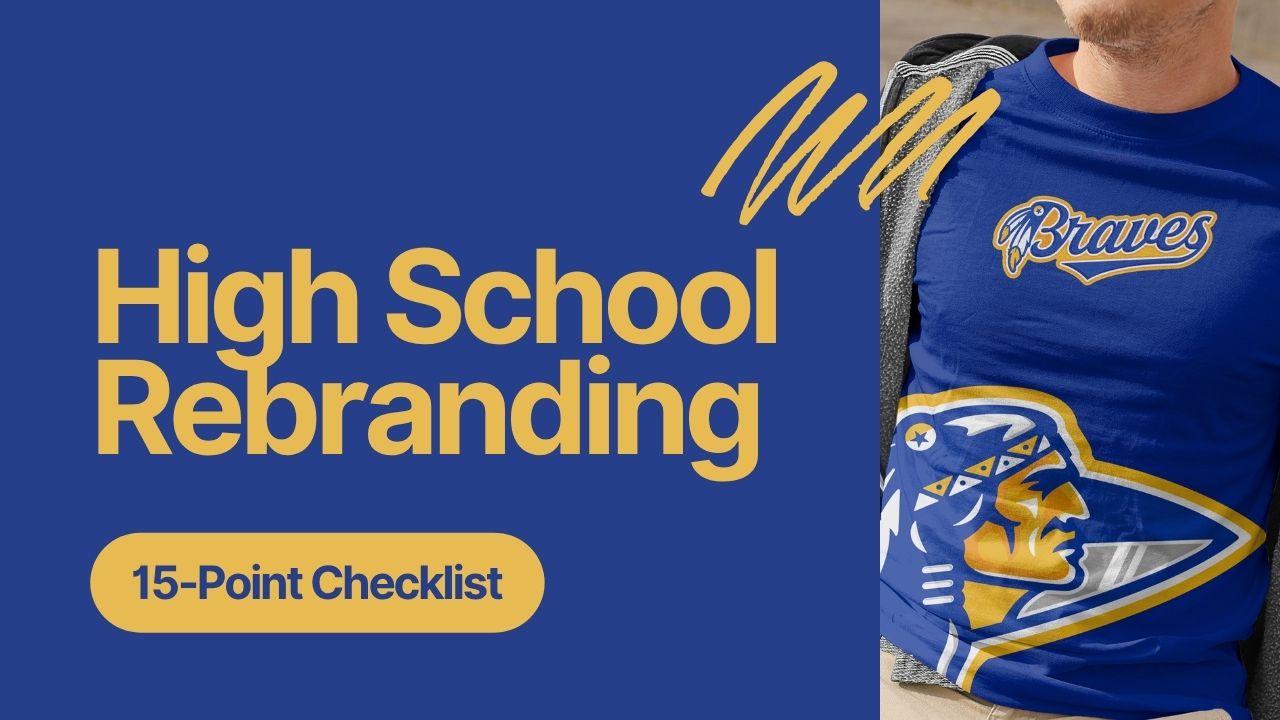School Branding Blog
High School Rebranding: When + How to Update Identity (2025)

TL;DR: High school rebranding is one of the most challenging educational branding projects due to deep alumni connections and tradition. However, it’s necessary when your current identity no longer serves your school’s goals or community. Success requires careful stakeholder management, honoring tradition while embracing change, and a phased implementation approach. Schools that rebrand thoughtfully see improved enrollment, stronger community pride, and better competitive positioning.
High school rebranding isn’t just about updating a logo—it’s about navigating decades of tradition, managing passionate alumni, and positioning your school for future success while honoring its past.
Unlike elementary schools where parents make decisions, or middle schools with shorter tenure, high schools carry generational weight. Your brand represents not just current students, but decades of graduates who see their identity reflected in your school’s image.
The question isn’t whether rebranding is risky—it’s whether not rebranding is riskier for your school’s future.
Planning a high school rebrand? Our high school branding services help schools navigate rebranding challenges while honoring tradition. Explore our visual identity design agency for complete rebrand packages.
When High School Rebranding Becomes Necessary
Clear Indicators It’s Time for Change
🚨 Urgent Rebranding Signals
- • Declining enrollment despite demographic growth
- • Outdated identity that embarrasses current students
- • Cultural insensitivity in current branding
- • Merger or consolidation requiring new identity
- • Negative community perception tied to visual identity
- • Competitive disadvantage in student recruitment
⚠️ Consider Rebranding When
- • Logo is 20+ years old and shows its age
- • Academic focus has shifted significantly
- • Community demographics have changed
- • Technology limitations with current design
- • Inconsistent brand application across materials
- • New leadership with different vision
The Cost of Waiting Too Long
Bridgewater-Raritan High School waited 15 years to update their 1970s-era logo. By the time they acted:
- Enrollment had dropped 23% over five years
- Students were embarrassed to wear school merchandise
- The community viewed the school as “behind the times”
- Recruiting quality teachers became increasingly difficult
Their rebranding investment of $12,000 resulted in:
- 34% increase in enrollment applications
- 67% increase in merchandise sales
- Improved teacher recruitment and retention
- Renewed community pride and support
The High School Rebranding Challenge: Stakeholder Complexity
High school rebranding involves more stakeholders with stronger opinions than any other educational level:
Stakeholder Map: Who Cares About Your Brand
Current Students
Want modern, cool identity they’re proud to wear
Parents
Want quality perception and community pride
Alumni
Deeply attached to tradition and memories
Community
See school as source of local identity
Managing Alumni Resistance
Alumni resistance is the biggest challenge in high school rebranding. Here’s how to address it:
Common Alumni Concerns:
- “You’re erasing our history”
- “The old logo was fine”
- “This is a waste of money”
- “You’re changing tradition”
Effective Response Strategies:
- Involve alumni in the process from the beginning
- Show respect for tradition while explaining necessity for change
- Demonstrate clear benefits to current students
- Preserve historical elements where possible
- Create legacy recognition opportunities
The Strategic Rebranding Process
Phase 1: Assessment and Planning (Months 1-2)
Comprehensive Brand Audit:
- Current brand perception across all stakeholder groups
- Competitive analysis of other schools in your area
- Historical brand evolution and significant milestones
- Technical assessment of current brand applications
Stakeholder Research:
- Student focus groups and surveys
- Parent and community interviews
- Alumni feedback sessions
- Staff and faculty input sessions
Research Questions That Matter
- • What makes our school unique in the community?
- • What traditions are most important to preserve?
- • How do current students feel about our identity?
- • What would make alumni proud to support the school?
- • How do we compare to our biggest competitors?
Phase 2: Strategy Development (Month 3)
Brand Strategy Framework:
- Core Values: What principles guide your school?
- Unique Position: What sets you apart from other high schools?
- Target Audiences: Who are you primarily trying to reach?
- Brand Personality: How should your school feel to experience?
- Visual Direction: What aesthetic supports your strategy?
Change Management Strategy:
- Communication timeline and key messages
- Stakeholder engagement plan
- Resistance management protocols
- Success metrics and measurement plan
Phase 3: Design Development (Months 4-5)
Collaborative Design Process:
- Concept Development: Multiple directions based on strategy
- Stakeholder Review: Structured feedback from key groups
- Refinement: Incorporating feedback while maintaining strategic direction
- Testing: How designs perform across applications and audiences
- Finalization: Complete brand system development
Key Design Considerations for High Schools:
Tradition Balance
Honor history while embracing modernity
Athletic Integration
Work across all sports and activities
Scalability
From business cards to stadium signage
Phase 4: Implementation Planning (Month 6)
Phased Rollout Strategy:
- Phase 1: Internal materials and communications
- Phase 2: Student-facing applications and merchandise
- Phase 3: External signage and major installations
- Phase 4: Athletic uniforms and equipment
Budget Allocation:
- 30% - Design development and brand guidelines
- 25% - Signage and major installations
- 20% - Athletic uniforms and equipment
- 15% - Marketing materials and communications
- 10% - Contingency and unexpected needs
Case Study: Successful High School Rebranding
Riverside High School: From Resistance to Pride
The Challenge
Riverside High’s 1980s “Raiders” identity featured a problematic mascot and outdated design. Enrollment was declining, and students were embarrassed by their school’s image. However, alumni were fiercely protective of the “Raiders” tradition.
The Solution
Rather than abandoning the “Raiders” name, we evolved it. The new identity featured a ship’s compass and anchor, connecting to the school’s riverside location while maintaining the adventurous spirit of “Raiders.” The tagline “Charting New Waters” honored exploration while signaling progress.
Common High School Rebranding Mistakes
1. Ignoring Alumni Input
Mistake: Making changes without consulting graduates who have deep emotional connections. Solution: Create alumni advisory committees and feedback opportunities throughout the process.
2. Changing Everything at Once
Mistake: Completely abandoning all historical elements and traditions. Solution: Identify which elements to preserve, evolve, or replace strategically.
3. Underestimating Athletic Impact
Mistake: Not considering how the rebrand affects sports teams, uniforms, and athletic identity. Solution: Plan athletic integration from the beginning, including uniform replacement timelines.
4. Poor Communication Strategy
Mistake: Surprising stakeholders with changes instead of building understanding and buy-in. Solution: Develop comprehensive communication plans with regular updates and feedback opportunities.
5. Insufficient Budget Planning
Mistake: Underestimating the cost of replacing signage, uniforms, and materials across a large campus. Solution: Create detailed implementation budgets with contingency funds for unexpected needs.
Measuring Rebranding Success
Key Performance Indicators
Immediate Metrics (0-6 months)
- • Stakeholder satisfaction surveys
- • Merchandise sales volume
- • Social media engagement rates
- • Media coverage sentiment
- • Implementation milestone completion
Long-term Metrics (6+ months)
- • Enrollment applications and retention
- • Alumni engagement and donations
- • Community perception surveys
- • Teacher recruitment success
- • Athletic program participation
Timeline and Budget Expectations
Typical High School Rebranding Timeline
- Months 1-2: Research and assessment
- Month 3: Strategy development
- Months 4-5: Design development and testing
- Month 6: Implementation planning
- Months 7-12: Phased rollout and implementation
- Year 2: Full implementation and refinement
Investment Ranges
- Small High School (500-1000 students): $15,000-$35,000
- Medium High School (1000-2000 students): $35,000-$65,000
- Large High School (2000+ students): $65,000-$120,000
Costs include design development, brand guidelines, signage updates, and initial implementation. Athletic uniforms and major facility updates may require additional investment.
Making the Case for High School Rebranding
Building Internal Support
For Administration:
- Present enrollment and competitive data
- Show ROI from similar school rebrandings
- Demonstrate community perception research
- Outline phased implementation to manage costs
For School Board:
- Provide comprehensive research and strategy
- Show stakeholder support and involvement
- Present clear success metrics and timelines
- Address budget concerns with detailed planning
For Community:
- Emphasize respect for tradition and history
- Show how rebranding serves current students
- Demonstrate competitive necessity
- Highlight community pride and economic benefits
Your Rebranding Decision Framework
Ask yourself these critical questions:
- Is our current identity serving our students’ best interests?
- Are we losing competitive advantage due to outdated branding?
- Do we have the stakeholder support necessary for success?
- Can we invest the time and resources needed for proper implementation?
- Are we prepared to manage the change process effectively?
If you answered “yes” to most of these questions, rebranding may be the strategic move your high school needs.
Ready to Honor Your Past While Embracing Your Future?
High school rebranding is complex, but when done thoughtfully, it creates renewed pride, improved enrollment, and stronger community connections that benefit generations of students.
Our high school rebranding service specializes in navigating the unique challenges of updating established school identities. We understand how to honor tradition while positioning schools for future success.
See the transformation: Discover how we helped Bridgewater-Raritan High School create a modern identity that increased alumni engagement by 78% while attracting record enrollment numbers.
Ready to explore what’s possible for your high school? Our rebranding assessment helps you understand the process, timeline, and investment for updating your school’s identity while honoring its proud tradition.
We Build and Manufacture Mascot Costumes
A professionally built mascot costume creates unforgettable moments at games, rallies, and community events.

See Full Details →
Design to Delivery
We manage everything
6-12 Week Delivery
In time for your season
Safety First
Ventilation & visibility
Starts at $2,500
Professional quality
About Mash Bonigala
Mash Bonigala is the Founder & CEO of School Branding Agency. Over the past 15 years, he's helped 250+ K-12 schools transform their brand identity and drive enrollment growth. From charter schools to public districts, Mash specializes in creating mascot systems and brand strategies that rally communities, boost school spirit, and convert prospects into enrolled families. Schedule a Zoom call to discuss your school →
Mascot logo design
Get an enrollment-ready mascot your community loves
Start with our mascot logo design service. We’ll craft a distinctive, on‑brand mascot system and rollout plan tailored for your school.
Start your estimateRelated
Charter Application Branding - Professional Identity for Authorizer Approval
Professional charter application branding that demonstrates operational readiness to authorizers. Complete brand identity, website, and application materials. Charter-specific packages from $8K.
View detailsRelated
Charter School Branding - Mascots & Identity (2025)
We help charter schools build mascots and identity systems that rally communities and support enrollment. See packages and proof.
View details
